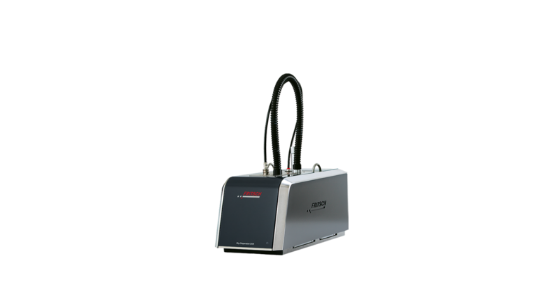AT A GLANCE
- Dry measurement of powdery samples in an accelerated airflow
- Efficient degradation of agglomerates
- Automatic computer-controlled adjustment of the dispersion pressure
- Freely programmable measurement processes
- Especially fast and easy to clean
IDEAL FOR
- MEASURING THE PARTICLE SIZE DISTRIBUTION OF DRY POWDERS
- MEASURING RANGE 0.1 – 2100 μm
- PRODUCTION AND QUALITY CONTROL
- RESEARCH AND DEVELOPMENT
OVERVIEW
Dry dispersion is especially suited for not too fine, free-flowing materials, which react in water or other liquids. The sample material is transported with a vibratory feeder through the intake funnel into the dry measuring cell, where it falls directly into a Venturi nozzle operating with an adjustable flow of compressed air. Upon passing through the nozzle, agglomerates are broken up and the measurement of the particle size dispersion in the laser beam takes place directly behind it. For dry dispersion the required sample volume is 1 – 100 cm3, which is larger compared to wet dispersion; however it is also easier to obtain a representative analysis.
DISPERSION PROCESS
With a high-frequency feeder the sample material is continuously transported over the funnel-shaped opening of the dry measuring cell and then drops in the actual dispersion area. In an annular gap Venturi nozzle the powder is accelerated and passes with a high speed through the nozzle channel and the measurement of the particle size distribution in the laser beam takes place directly behind it. Then it passes a zone with aerodynamic wave generation at the nozzle outlet. The by the high turbulent current caused strong shearing forces, as well as blows between the particles lead to the breakdown of the agglomerates. No impact areas in the flight path of the particles exist in order to prevent soft sample materials from being ground during the dispersion process.
Compared with the wet dispersion is the dry dispersion not as efficient due to chemically-physical as well as rheological material properties of the sample material.
One of the main differences between dry and wet dispersion is based on the fact, that it is almost a solely mechanical dispersion in an air flow. Thereby, with a dry dispersion, a sensible measurable particle size and the associated complete primary particle dispersion is typically at approximately 1 - 10 µm. Depending on the material and its properties, below this range an incomplete dispersion can be expected. The utilization of the dry dispersion makes sense in areas where a wet dispersion in water or solvents has to be ruled out.
FULLY PROGRAMMABILITY
The dispersion pressure is set with the assistance of SOP’s with the software MaS control and then is carried out automatically. Measurement processes can therefore be freely programmed and the entire measurement takes place completely automatic.
INTEGRATED FEEDING - FRITSCH-PATENT
An electronically controlled high-frequency feeder ensures automatic continuous feeding of powdery samples without residues when using the dry dispersion unit.
FRITSCH-Plus: A vibrating funnel, which is simply pushed onto the feeder, ensures uniform and homogeneous feeding of the sample.
FRITSCH-patent: Easy-to-change channel inserts with funnel, which are pushed onto the feeder for defined layer heights between 1.5 and 4.5 mm. Your advantage: more easily controlled feeding even of critical samples.
COMPRESSED AIR CONNECTION
For the operation of the dry dispersion unit, an oil-, water- and particle-free supply of compressed air with a pressure of at least 5 bar and an air volume of at least 125 l/min is required. An external exhaust system is necessary to vacuum the sample material and can be ordered as a FRITSCH accessory together with the instrument.
MULTIFUNCTIONAL EXHAUST SYSTEM
The integrated exhaust system of the dry dispersion unit ensures automatic sample exhaust during the measurement. When the measurement is completed it can also be easily used to manually clean the feeder. An external exhaust system is necessary to vacuum the sample material and can be ordered as a FRITSCH accessory together with the instrument.
FEATURES
- Fast measurement of powdery samples in an accelerated airflow
- For sample volumes from less than 1 cm3 to approx. 100 cm3
- Efficient degradation of agglomerates with a special annular gap Venturi nozzle
- No impact areas – protection against comminution of the particles
- Perfect sample feeding with high frequency feeder
- Automatic computer-controlled adjustment of the dispersion pressure
- Fully automatic, freely programmable measurement processes
- Especially fast and easy to clean
- Conversion kit to use the dry dispersion unit as a falling chute
EQUIPMENT
In order to use the FRITSCH Dry Dispersion Unit you will need the ANALYSETTE 22 NanoTec Measuring Unit (Order No. 22.8800.00) and an exhaust system.

